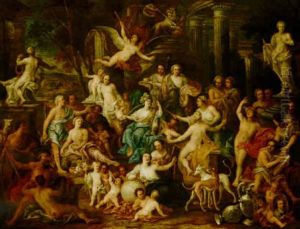Jan Baptist Herregouts Paintings
Jan Baptist Herregouts was a Flemish painter, draughtsman, and printmaker, born in 1646 in Bruges, which was then part of the Spanish Netherlands. His father, Hendrick Herregouts, was also a painter, which suggests that Jan Baptist likely received his early training in the arts from his father. This was a common practice at the time, where artistic skills and workshops were often passed down from one generation to the next.
After his initial training, Herregouts went on to work in various cities. His movements across Europe were typical for artists of his time, who often traveled in search of commissions and new influences. He spent time in Italy, particularly in Rome, which was a key center for artistic learning and practice during the 17th century. The influence of Italian art and the Baroque style is evident in his works, which often featured dramatic lighting, intense emotions, and a strong sense of movement.
Herregouts was versatile in his subject matter and produced religious compositions, genre scenes, and portraits. Despite his evident skill, he did not gain the same level of fame as some of his contemporaries. Nevertheless, his work was appreciated by a discerning clientele, and he received commissions from various religious institutions and private patrons.
In the latter part of his life, Herregouts returned to the Low Countries, settling back in Bruges. There, he continued to paint and contribute to the city's artistic community. His works from this period reflect the continued influence of the Baroque style but also show a deepening of his personal artistic voice. Jan Baptist Herregouts died in Bruges in 1721, leaving behind a body of work that, while not as widely known as some of his peers, demonstrates the rich cultural exchange and development of Baroque art across Europe.


